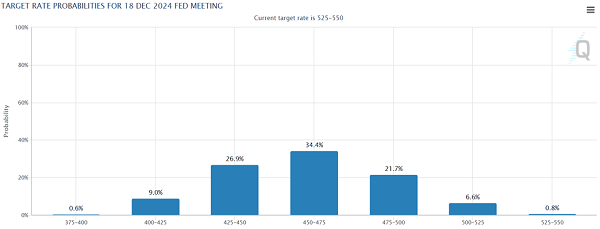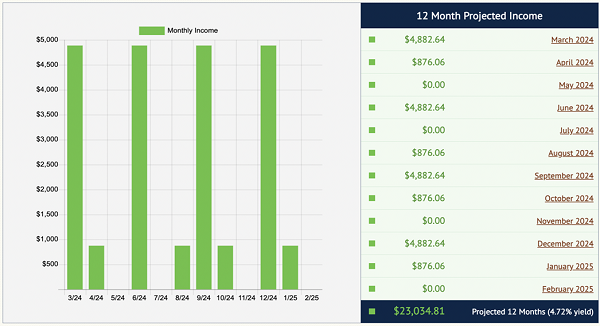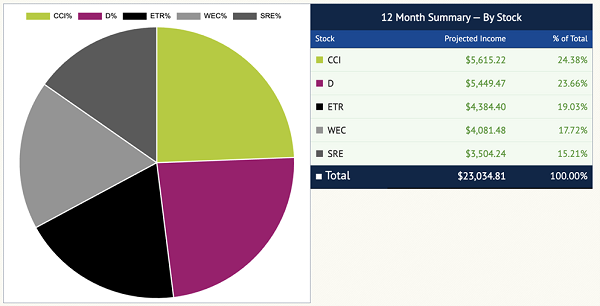I think we can all agree that interest-rate cuts are on the table now. Even Jay Powell says so!
That rare “straight talk” from mystery-man Jay has fueled a jump in bonds. But there are still some bargain “bond proxies” on the table waiting to be snapped up.
To be sure, Jay is still being cagey about when the first cut will drop. But futures traders think they’re on to him: they’re calling for at least three quarter-point cuts by the end of this year, as of this writing:

Source: CME Group
We can argue about whether or not that’s too aggressive. But no matter when or how many, rate cuts are coming, and they’ll continue to drive bonds (and stocks and funds that behave like bonds) higher in the months ahead.
But funnily enough, even though Jay is being as clear as a bell, there are still cheap “bond proxies” on the board for us.
Case in point: utility stocks, which tend to trade opposite to bond yields. As you’d expect, many of these stocks have spiked in the last few months as Treasury rates moved down from their recent peak of nearly 5% back in October. But there are still a few “delayed reaction” utility buys on the board for us today.
We’ll build a “mini-portfolio” of these perfectly positioned dividend payers (and growers) below.
But let’s start with Virginia-based Dominion Energy (D), which has six million electricity and gas customers across 16 states. And talk about cheap: this one trades at 16.4-times forward earnings (well below its five-year average of 19.4-times) and yields around 5.6%.
As you can see from its 10-year yield history below, Dominion rarely pays this much.
Dominion’s Dividend Yield Runs Near All-Time Highs

Why the deal? D’s in the doghouse because the company cut its payout in late 2020. Why the chop? Too much debt, of course. Dominion had embarked on an acquisition binge in the name of growth. Which, ironically, backfired.
The result was a rare payout slash from a utility—that’s why first-level investors keep Dominion in the doghouse.
Which intrigues us here at Contrarian Outlook. Chief financial officers (CFOs) are like carpenters. It’s best if they measure twice and cut only once. As a result, the safest dividend is often the one recently cut. Unless management is a complete clown show, the last thing they want is to have to cut twice!
Which is why a recent dividend raise from Dominion—definitely not a management clown show—is encouraging. It shows confidence that the current dividend is being paid comfortably. Moreover, we can expect lower rates to reduce the company’s borrowing costs. And in any event, that 2020 cut has long been priced into D’s valuation (and high yield).
A Simple Way to Track Your “Bond Proxy” Payouts
Now that we’ve talked about the opportunity (still) waiting for us in utilities like D, I wanted to let you know about one more thing.
It’s a new tool we’ve created that lets you ditch the spreadsheet you normally use to track your dividend payouts and manage your income stream with much less hassle.
Like most people, my bills come in every month. And I’m not cutting checks any longer; most of my expenses are on autopay. Which makes income tracking more important than ever. I need to make sure I have the money in the account before it gets dinged.
That’s where our new toy whipped up by our IT team here at Contrarian Outlook, called the Income Calendar, comes in.
Let’s do a quick run-through, using D and four other utility stocks that stand to gain as the 10-year Treasury yield drops further: Entergy (ETR), a 4.4%-payer; WEC Energy (WEC)—current yield: 4.1%; California-based Sempra (SRE), with a 3.5% payout; and Crown Castle International (CCI), which is technically a REIT, not a utility, but I’d argue the company’s cell towers are just as vital as power lines these days. CCI’s yield rings in at 5.7%.
Let’s go ahead and plug these five quarterly payers into Income Calendar, allocating $100,000 to each one, for a $500,000 sample portfolio in total.
Right away, IC gives us the vitals—no finicky Excel formulas needed!

On the left, we’ve got an “at a glance” custom 12-month income forecast served up for us in an easy-to-read bar chart. (You’ll note we don’t get any payouts in February, May, July and November here, but that’s okay—we’re building for quality, not frequency here. And with Income Calendar’s help, we can smooth out our payouts on our own to compensate.)
On the right, Income Calendar gets granular, giving us a dollars-and-cents monthly forecast, including our total projected income for the year of $23,034.18, good for a 4.7% yield. Not bad!
(And note that we intentionally don’t forecast dividend growth in IC, to be as conservative as possible, but as all five of these stocks have dividend-growth histories, we could likely expect a bit more than 4.7% as the next 12 months play out.)
There’s more. Let’s dial up June 2024, a month in which we get paid by Entergy, WEC, Dominion and Crown:

You can see that Income Calendar not only tracks our payouts but forecasts other key dates, like the ex-dividend date (or the date by which you need to be a shareholder to receive the next payout) and non-dividend-related events like market holidays.
It’ll also tip you off to expected earnings dates (there aren’t any of those in June 2024, but they normally show up in red). Moreover you can get a breakout by stock, too:

Let’s see an Excel spreadsheet do all that! Income Calendar really is a complete roadmap that makes sure you’re always on top of what’s coming up for your holdings, and you’re never caught short of dividend cash when you need it.
One final note—we’ve recently made a major upgrade to IC: we’ve integrated it with Plaid, a service that safely and securely links up to your brokerage account and imports all your tickers and share counts—so you don’t have to do any inputting at all.
It’s easy to use, and if you appreciate convenience (who doesn’t?), I’m sure you’ll love it.
My Personal Invitation to You: Try Income Calendar With No Obligation
The best way for you to see what Income Calendar could do for you is to try it out yourself. Log in, drop in a few tickers. Maybe include a couple stocks you’ve been watching, just to see how your income stream could change with an extra buy or two.
I think you’ll quickly see how this new tool can save you valuable time—and give you peace of mind that your dividend cash will be in your account before your bills come out.
It couldn’t be easier to set up, and you’ve got no obligation whatsoever.
Simply click here to see the investor briefing I’ve put together on Income Calendar, including a quick video that demonstrates, step by step, exactly how to use it. You’ll also get a chance to “road test” the service for 60 days.
This is the perfect time to try this new tool and get the next 12 months of dividend payouts lined up. Give it a shot today!
Before you make your next trade, you'll want to hear this.
MarketBeat keeps track of Wall Street's top-rated and best performing research analysts and the stocks they recommend to their clients on a daily basis.
Our team has identified the five stocks that top analysts are quietly whispering to their clients to buy now before the broader market catches on... and none of the big name stocks were on the list.
They believe these five stocks are the five best companies for investors to buy now...
See The Five Stocks Here
Click the link below and we'll send you MarketBeat's guide to investing in electric vehicle technologies (EV) and which EV stocks show the most promise.
Get This Free Report